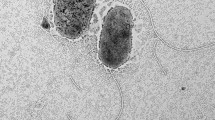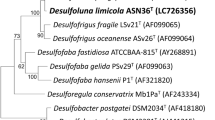Abstract
A new hyperthermophilic, strictly anaerobic crenarchaeote, Stetteria hydrogenophila DSM11227 representing a new genus within the family of Desulfurococcaceae, was isolated from the sediment of a marine hydrothermal system at Paleohori Bay in Milos, Greece. Cells are gram-negative irregular and disc-shaped cocci, 0.5–1.5 μm in diameter, which are flagellate and can form cytoplasmatic protrusions up to 2 μm in length. The strain grew optimally at 95°C at pH 6.0 and at a NaCl concentration of 3%. The organism grew mixotrophically on peptide substrates. It required elemental sulfur as an external electron acceptor, and in addition, its growth was completely dependent on the presence of molecular hydrogen. Sulfur could be replaced by thiosulfate. H2S, CO2, acetate, and ethanol were identified as products of metabolism. The G + C content of DNA was 65 mol%. Analysis of its phylogenetic position by sequence analysis of 16S rRNA placed this organism in the family of Desulfurococcaceae. The dependence of this organism on both hydrogen and sulfur during growth on peptide substrates distinguishes Stetteria from all previously described species of Crenarchaeota.
Similar content being viewed by others
Author information
Authors and Affiliations
Additional information
Received: September 4, 1996 / Accepted: November 12, 1996
Rights and permissions
About this article
Cite this article
Jochimsen, B., Peinemann-Simon, S., Völker, H. et al. Stetteria hydrogenophila, gen. nov. and sp. nov., a novel mixotrophic sulfur-dependent crenarchaeote isolated from Milos, Greece . Extremophiles 1, 67–73 (1997). https://doi.org/10.1007/s007920050016
Issue Date:
DOI: https://doi.org/10.1007/s007920050016




